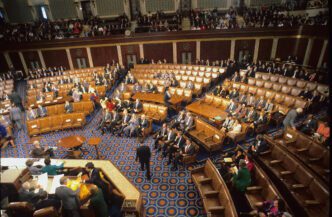Executive Summary
The Story So Far
Why This Matters
Who Thinks What?
President Donald Trump’s tariff policy is projected to cost most American households significantly more than the benefits received from his administration’s tax cuts, according to analysis from the Yale Budget Lab. While Republicans and President Trump have championed the tax cuts as historic, and Democrats have criticized tariffs as a major tax hike, the Yale Budget Lab’s calculations indicate that the average American household could face an additional $2,300 in costs due to current tariff policies, nearly triple the estimated $800 average benefit from new tax provisions.
Understanding the Financial Impact
The debate surrounding President Trump’s “One Big Beautiful Bill Act” tax cuts and his global tariff policy highlights complex financial implications for U.S. households. John Ricco, associate director of policy analysis at the Yale Budget Lab, stated that “for households as a whole, the total tax increase they’ll feel from tariffs is larger than the total tax cut they’ll feel from the new provisions in the Republican tax package.”
Several variables complicate a direct comparison. Economists note that tariffs have not yet triggered the widespread inflation many predicted, although a gradual increase is occurring. The full impact of these tariffs, many of which were recently implemented, may also be delayed. Furthermore, the sheer size and decentralization of the U.S. economy mean that numerous factors beyond just tariffs and taxes influence consumer costs.
Disparate Effects Across Income Brackets
A detailed analysis by the Yale Budget Lab reveals that only the highest earners are likely to see a net financial gain over the next decade when considering both tariffs and tax cuts. The top 10% of households, with an average annual income of $518,000, are projected to pay approximately $13,600 less in taxes while incurring about $5,450 more due to tariff-induced price increases. This combination results in an estimated income boost of $8,200, or 1.6%.
Conversely, middle-income households, earning between $105,000 and $122,000 annually, are expected to find their average $1,200 tax cut more than offset by a cumulative $2,200 tariff price hike. The most significant negative impact is anticipated for the lowest earners. The bottom 10% of households, with an average income just under $39,000, could see their average annual income drop by almost $2,600, or 6.6%. This includes an average $1,350 hit from tariffs and roughly $1,200 from cuts to the social safety net, which were part of the Republican tax package.
Ricco emphasized that the higher cost of goods from tariffs disproportionately affects lower-income consumers because they spend a larger share of their income compared to wealthier individuals. A separate Yale report highlighted that while the wealthiest Americans might lose nearly $5,250 in disposable income by 2027 due to higher prices, this represents only 1% of their income. For the bottom 10%, a loss of over $1,300 accounts for 3.5% of their disposable income.
Tax Cuts and Safety Net Reductions
Republicans and President Trump have argued that the tax cuts are much larger than the tariffs, an assertion that, according to the analysis, overlooks a critical detail: many of the tax cuts are extensions of temporary policies from President Trump’s first term rather than entirely new reductions. Specific measures, such as a temporary reprieve for taxes on tips, benefit only a small fraction of the workforce.
The tax bill also includes cuts to vital social safety net programs like food assistance and Medicaid. These reductions are expected to lead to millions of people losing benefits, negatively impacting their quality of life and financial stability. A separate Yale analysis suggests that the cost burden of tariffs alone could push hundreds of thousands of Americans into poverty in the coming year.
Broader Economic and Fiscal Implications
Tariffs function as a national sales tax on imported goods, with rates varying and subject to change. Their long-term impact could evolve, especially if, as President Trump promised, they catalyze a U.S. manufacturing resurgence.
Beyond individual households, the two policies have contrasting effects on the nation’s fiscal health. The Congressional Budget Office (CBO) estimates that beefed-up tariffs, as of August 19, are projected to lower the federal deficit by $3.3 trillion between 2025 and 2035 and reduce interest costs by an additional $700 billion, totaling a $4 trillion impact. Conversely, the GOP tax and spending cuts package is expected to increase the federal debt by an estimated $4.1 trillion between 2025 and 2034, projecting a $3.4 trillion increase in the deficit and adding roughly $718 billion in interest costs.
Joseph Rosenberg, a senior fellow at the Urban-Brookings Tax Policy Center, notes that “tax cuts are higher for higher-income people, whereas tariffs have the opposite effects; they are much more evenly distributed.” This means tariffs disproportionately impact lower-income Americans. Even if the fiscal impacts of tariffs and tax cuts were to cancel each other out, the combined effect of these policies could exacerbate economic inequality. The tax cuts are described as “riddled with special interest carveouts,” while tariffs also hit certain industries harder than others. Observers suggest that these changes indicate a movement toward a “far more unequal and unstable fiscal system.”








